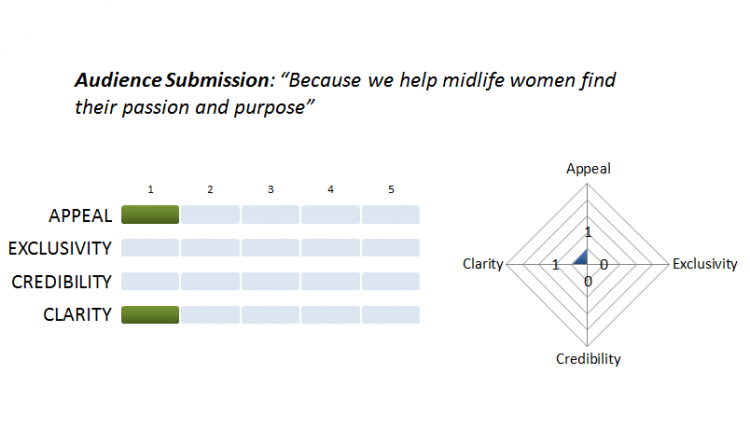Ahhhhhh, Fall. There’s a chill in the air. Football is back. And, if you’re a marketer, it’s time once again for MarketingSherpa’s annual B2B Summit, currently happening in Boston, and soon to invade San Francisco.
We’re live onsite, and Dr. Flint McGlaughlin, Managing Director and CEO, MECLABS, opened the proceedings this morning by teaching this enthusiastic audience that most marketers can’t even define “value proposition,” much less tell you their own. Dr. McGlaughlin was out to change this, by helping the audience define the very questions necessary to establish a strong value prop, and differentiate them from competitors.
The fourth step of Dr. McGlaughlin’s six-step process involves a strategic checkpoint in which you measure the potential force of your value proposition(s).
As Dr. McGlaughlin has taught before, “clarity trumps persuasion.” This applies particularly well to value proposition, as we learned value propositions are discovered, not determined. They don’t come about from something that is predetermined; they grow out of what you are as a company or product. This sincerity needs to come through in a value proposition.
Dr. McGlaughlin showed how creating a value prop, measuring its force, and clearly communicating it to the world, let some marketers off the hook, in a sense. You don’t need to be an expert copywriter. You are simply communicating the unique value that your audience is looking for.
But how do you do it? The force of a value proposition can be measured by four essential elements of the offer:
- Appeal – How much do I desire this offer?
- Exclusivity – Where else can I get this offer?
- Credibility – Can I trust your claims?
- Clarity – What are you actually offering?
For the purposes of this presentation, we asked some attendees to submit what they feel their best value propositions are, and measured each for the above four elements.
–
Audience Submission #1:
–

–
Dr. McGlaughlin started off the submission review with a seemingly direct attempt at a value proposition that, in reality, doesn’t address two of the four necessary elements for measuring force. While terms like “help,” “passion” and “purpose” carry some appeal, the lack of specificity and context ultimately lowers that score.
Likewise, there is nothing in the above statement that indicates there is any inherent exclusivity. “Helping mid-life women … ” (a term I’m not entirely comfortable with, to be honest; but we’ll save that for another blog post) – “… find their passion and purpose” could apply to any number of products, services or outlets, which also affects the clarity score.
At no point do I feel comfortable that this particular company is offering something I cannot find anywhere else, prompting me to conduct more research … likely at another website.
–
Audience Submission #2:
–

–
The second submission, as you can see, scored considerably higher in most categories. There is a noticeable improvement in appeal from the first submission, as this value proposition addresses the company’s products from a number of angles – “cute,” “soft,” “durable,” “sun-protective,” etc. This sequence of adjectives moves logically, from subjective to objective, ending with a descriptor that would likely appeal to someone searching for such specialized clothing items.
This submission also scored somewhat well on credibility and clarity, as the statement is fairly clear in expressing the company’s value. However, while the descriptors could interest a particular type of buyer, it is nowhere near specific enough to seal the proverbial deal. How many types of sun-protected items do they sell? Do they cater to children and adults? Is there proof of the products’ effectiveness?
These questions seem minor, considering the answers are likely found on a company homepage. But this level of vagueness – and requiring the audience to dig deeper to find value – could cost the company a considerable amount of business.
–
Audience Submission #3:
–

–
The final audience submission proved to be relatively strong in some areas, while deceptively weak in others. The submission’s appeal comes from the inclusion of “up-to-date” and “highly actionable” – terms which speak well to marketers, and play well with the company’s claim of exclusivity as the only provider of these reports.
However, once the excitement of this bold statement wears off, this value proposition does nothing to reinforce its claims. There is no proof offered to support the company’s claim that this is the only way to read this research, nor is there any evidence that this company is known for exclusive products.
Likewise, how does this proposition support the idea that these visuals and case studies are actionable? Do they contain exclusive, relevant tips and how-to information? It’s unclear of what separates this product from any other in the category. As such, this lack of credibility ultimately exposes a lack of clarity as well.
I could go on for another few pages, but let me get back to the sessions at B2B Summit 2011. There’s plenty more information and detail to be had by following the conversation at #B2Bsummit, and by attending the second of our two B2B Summits in San Francisco.
–
Related Resources:
MarketingSherpa B2B Summit 2011 in San Francisco
Value Proposition: A free worksheet to help you win arguments in any meeting
Do You Have the Right Value Proposition? – Web Clinic replay
Online Reviews: How to start discovering your value proposition with Yelp
Value Proposition: A free worksheet to help you win arguments in any meeting
Value Prop: Is there true value in your marketing proposition?
–




Great post! I’m getting tired of tweeting out your stuff but it’s so damn good.
?: How are you measuring these? Is it just judgement or is their something more to it?
Thanks!